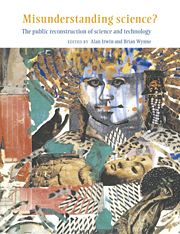Book contents
- Frontmatter
- Contents
- Acknowledgements
- Introduction
- 1 Misunderstood misunderstandings: social identities and public uptake of science
- 2 Science and Hell's kitchen: the local understanding of hazard issues
- 3 Disembodied knowledge? Making sense of medical science
- 4 Now you see it, now you don't: mediating science and managing uncertainty in reproductive medicine
- 5 Ignoring science: discourses of ignorance in the public understanding of science
- 6 Insiders and outsiders: identifying experts on home ground
- 7 Authorising science: public understanding of science in museums
- 8 Nature's advocates: putting science to work in environmental organisations
- 9 Proteins, plants, and currents: rediscovering science in Britain
- Conclusions
- Notes on contributors
- Select bibliography
- Index
1 - Misunderstood misunderstandings: social identities and public uptake of science
Published online by Cambridge University Press: 16 October 2009
- Frontmatter
- Contents
- Acknowledgements
- Introduction
- 1 Misunderstood misunderstandings: social identities and public uptake of science
- 2 Science and Hell's kitchen: the local understanding of hazard issues
- 3 Disembodied knowledge? Making sense of medical science
- 4 Now you see it, now you don't: mediating science and managing uncertainty in reproductive medicine
- 5 Ignoring science: discourses of ignorance in the public understanding of science
- 6 Insiders and outsiders: identifying experts on home ground
- 7 Authorising science: public understanding of science in museums
- 8 Nature's advocates: putting science to work in environmental organisations
- 9 Proteins, plants, and currents: rediscovering science in Britain
- Conclusions
- Notes on contributors
- Select bibliography
- Index
Summary
This chapter takes as its focus one very specific example of public interaction with science – the case of the hill sheep-farmers of the Lake District of northern England. They experienced radioactive fall-out from the 1986 Chernobyl accident which contaminated their sheep flocks and upland pastures. In an area dominated by a traditional and demanding hill-farming economy, they were restricted from selling their sheep freely (almost 100 farms are still under restriction). They also received intensive expert advice about the environmental hazards from the radiocaesium deposits, and the relationship of these to other such deposits from the nearby Windscale-Sellafield nuclear facilities and 1950s weapons testing fall-out. Fieldwork comprising mainly in-depth interviews with affected farmers and others provided data for analysis of the factors influencing the reception of scientific expertise by this sub-population.
In analysing the farmers' understanding of the science, it was immediately apparent that it would have been meaningless and utterly misleading to treat their response to its cognitive content – for example, the claim that radiocaesium from Chernobyl was clearly distinguishable from Sellafield emissions of the same radio–isotopes – as if separate from its social and institutional form. Examining how the scientific institutions framed the issue and the knowledge they articulated as science, identified certain commitments which were institutionalised and taken for granted, thus not deliberately introduced. They constituted the very culture of science as institutionalised and practised as public knowledge. These assumptions shaped the scientific knowledge, they were not extra to it; and they were built in as social prescriptions in the way the science was institutionalised and deployed.
- Type
- Chapter
- Information
- Misunderstanding Science?The Public Reconstruction of Science and Technology, pp. 19 - 46Publisher: Cambridge University PressPrint publication year: 1996
- 215
- Cited by



